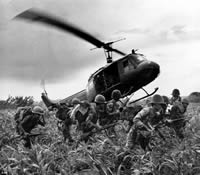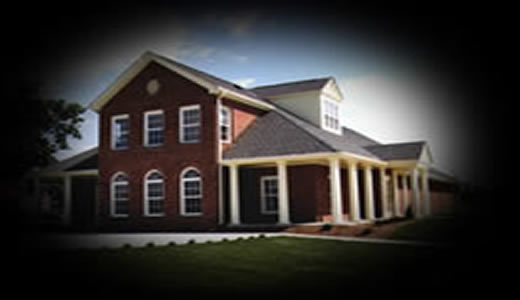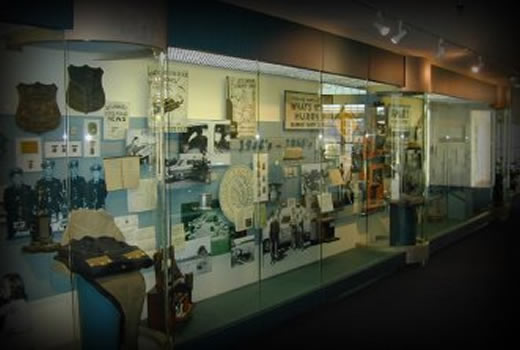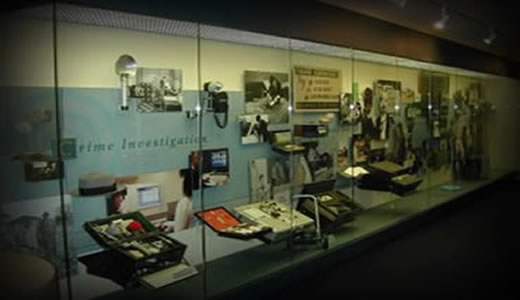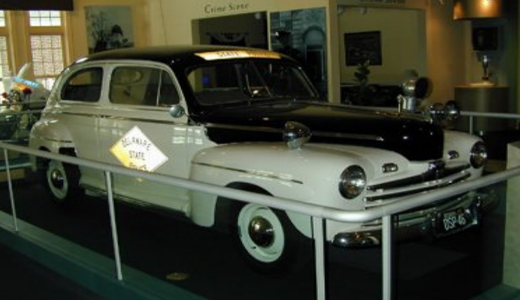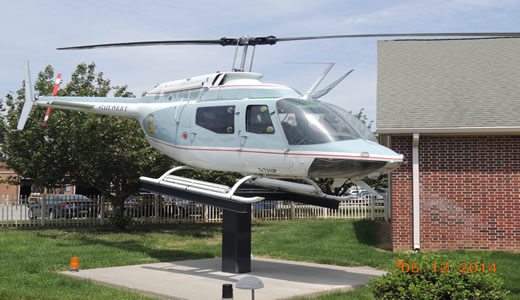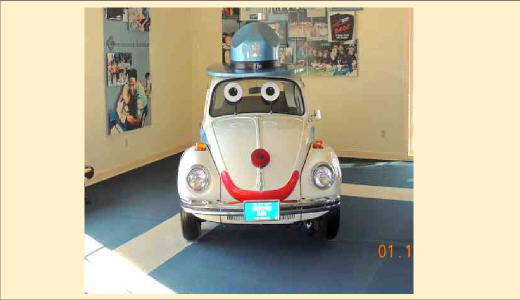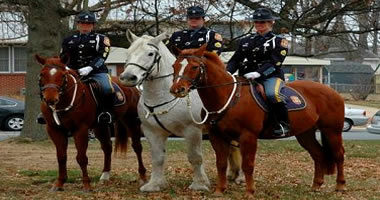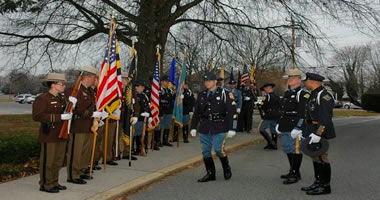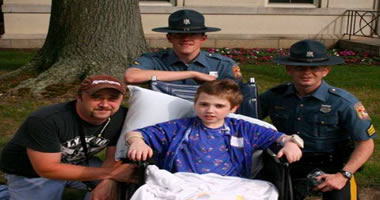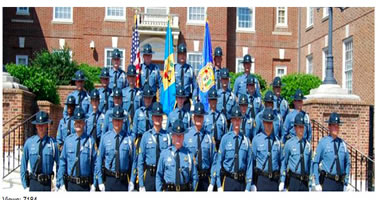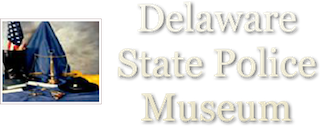History of the Delaware State Police - 1955-1959
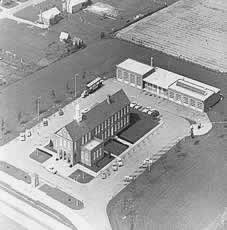
The 1950’s marked a period of tremendous growth for the State Police. Several new facilities were constructed to meet the needs of an expanding department, including the building and dedication of a new headquarters complex in Dover. A new technological weapon would be utilized in the war against crime, and already existing technologies would find new applications in the effort to increase safety on the highways of the First State. The decade would also see its share of tragedy, as four troopers lost their lives while in the performance of their duties.
The decade began with the construction of a new 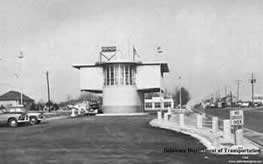 building near the intersection of Routes 40 and 13, at State Road in New Castle. The unique structure served as Troop 2 until February 1958, when the new state police headquarters was opened in Dover. This building, due to its appearance and design, was commonly known as the "Ferry Boat." The troop was built to address the increased traffic resulting from the opening of the Delaware Memorial Bridge in 1951. As this was a temporary troop, operations were later moved to the old headquarters building at State Road located north of Routes 40 and 13.
building near the intersection of Routes 40 and 13, at State Road in New Castle. The unique structure served as Troop 2 until February 1958, when the new state police headquarters was opened in Dover. This building, due to its appearance and design, was commonly known as the "Ferry Boat." The troop was built to address the increased traffic resulting from the opening of the Delaware Memorial Bridge in 1951. As this was a temporary troop, operations were later moved to the old headquarters building at State Road located north of Routes 40 and 13.
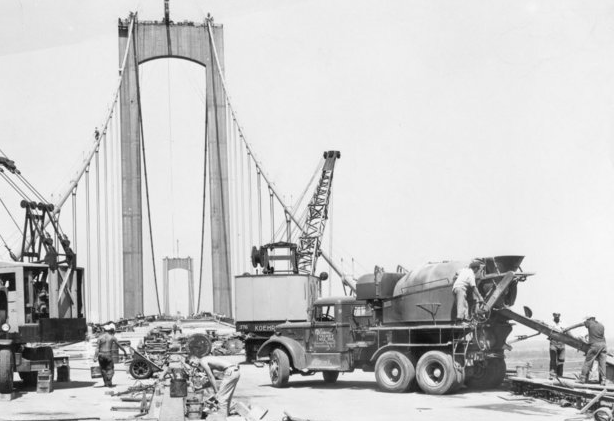 On January 26, 1956, the old
On January 26, 1956, the old 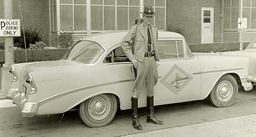 headquarters for the engineers who were building the Delaware Memorial Bridge became the new state police academy. This academy was entirely finished with classrooms and two additional rooms containing double-deck bunks which accommodated 24 men. Also in January, it was announced that a new headquarters and troop would be built in the state’s capital at the estimated cost of $410,000.
headquarters for the engineers who were building the Delaware Memorial Bridge became the new state police academy. This academy was entirely finished with classrooms and two additional rooms containing double-deck bunks which accommodated 24 men. Also in January, it was announced that a new headquarters and troop would be built in the state’s capital at the estimated cost of $410,000.
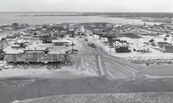 On May 27, 1957 the Delaware State Police opened its first sub-station, designated Troop 4A, located on Delaware 1, north of Dewey Beach. This substation was initially manned during the summer in order to compensate for the increased traffic and to receive complaints of any criminal activity in the resort areas.
On May 27, 1957 the Delaware State Police opened its first sub-station, designated Troop 4A, located on Delaware 1, north of Dewey Beach. This substation was initially manned during the summer in order to compensate for the increased traffic and to receive complaints of any criminal activity in the resort areas.
In the Spring of 1958, headquarters personnel were transferred from State Road, New Castle, to the new headquarters building in Dover. In July, 1958, 50 troopers and detectives were moved from the "Ferry Boat" to the old headquarters now known as Troop 2 on State Road.
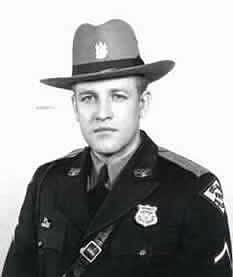
On August 7, 1955, Trooper William F. Mayer, 28, was ![]() killed in a traffic accident on the DuPont Parkway near the Duck Creek Bridge just north of Smyrna. Trooper Mayer had stopped a pickup truck for a traffic violation on the shoulder of the roadway. As he stood by the vehicle conversing with the operator, an approaching tractor-trailer ran off the roadway, striking the pickup and Trooper Mayer, who died as a result of injuries sustained in the collision. During the investigation, it was determined that the driver of the tractor-trailer had fallen asleep and, as a result, he was charged with manslaughter. Trooper Mayer was laid to rest at the Odd Fellows Cemetery in Dover.
killed in a traffic accident on the DuPont Parkway near the Duck Creek Bridge just north of Smyrna. Trooper Mayer had stopped a pickup truck for a traffic violation on the shoulder of the roadway. As he stood by the vehicle conversing with the operator, an approaching tractor-trailer ran off the roadway, striking the pickup and Trooper Mayer, who died as a result of injuries sustained in the collision. During the investigation, it was determined that the driver of the tractor-trailer had fallen asleep and, as a result, he was charged with manslaughter. Trooper Mayer was laid to rest at the Odd Fellows Cemetery in Dover.
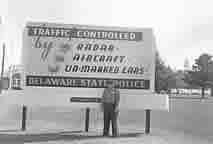
The middle of the decade witnessed the use of fixed-wing aircraft in the enforcement and prosecution of traffic law violators. On May 30, 1955, the state police made their first "air to ground" traffic arrest when a state police pilot observed a vehicle operating in a reckless manner on Route 13 in Odessa.
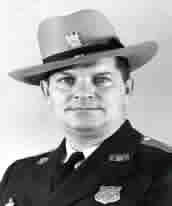
Two bills were brought before the legislature which would have a lasting impact on traffic safety in the state. On June 2, 1955, a bill was signed "permitting evidence obtained through use of an Intoximeter to be used in order to determine the state of sobriety of persons brought before the court." On January 5, 1959, Colonel Ferguson appeared before the General Assembly to urge passage of an "implied consent" bill, under which all drivers suspected of drinking while driving would be required to take a sobriety test or waive the right to drive in Delaware.
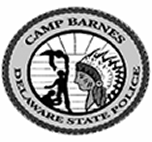 In March of 1958, the department announced the expansion of the summer youth camp later to be known as Camp Barnes in Sussex County. Ten new cottages were built to replace the old barracks. The following year, at a meeting of the Delaware Association of Chiefs of Police, Colonel Ferguson proposed that Camp Barnes be opened for deserving Delaware girls and boys.
In March of 1958, the department announced the expansion of the summer youth camp later to be known as Camp Barnes in Sussex County. Ten new cottages were built to replace the old barracks. The following year, at a meeting of the Delaware Association of Chiefs of Police, Colonel Ferguson proposed that Camp Barnes be opened for deserving Delaware girls and boys.
Several subtle changes to the uniform occurred during the decade and the department adopted a new 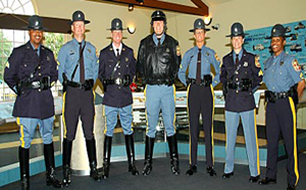 patch insignia. In June of 1956, after approval by the State Highway Commission, a revision of the uniform was authorized by Colonel Shew. Lightweight blue shirts with open collars and no ties replaced the long sleeved shirt and tie during the summer months. The felt Stetson hat was replaced by a straw Stetson which was blue-gray in color. The gold diamond patch worn on both shoulders of the uniform was replaced by a seven-color patch depicting the state seal which is currently a part of the uniform. The patch was worn on the left shoulder of the new uniform. In January of 1958, nameplates were added to the state police uniform.
patch insignia. In June of 1956, after approval by the State Highway Commission, a revision of the uniform was authorized by Colonel Shew. Lightweight blue shirts with open collars and no ties replaced the long sleeved shirt and tie during the summer months. The felt Stetson hat was replaced by a straw Stetson which was blue-gray in color. The gold diamond patch worn on both shoulders of the uniform was replaced by a seven-color patch depicting the state seal which is currently a part of the uniform. The patch was worn on the left shoulder of the new uniform. In January of 1958, nameplates were added to the state police uniform.
On March 8, 1956, thirty-three men graduated from the first post war trained auxiliary state police program. Their uniform consisted of white coveralls and helmets, with nightsticks fastened to their belt. This unit was formed in 1951, but was met with great opposition. Its implementation took five years because of uncertainties by the Highway Commission. The concept of the program was to train civilians in non-emergency tasks, allowing troopers to concentrate on more vital functions during large-scale emergencies.
On December 11, 1957, the State Highway Commission authorized the department to purchase two airplanes. It was suggested the planes be used for traffic 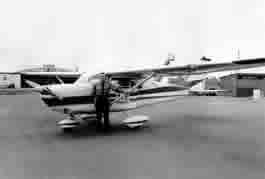 control and emergencies, such as aiding lost persons and boats. Prior to this time, the department had rented a single engine Cessna fixed wing aircraft which was manned by troopers on a part-time basis. An August issue of the Wilmington Morning News explained, "The Delaware State Police will take to the air in the fight against crime, improving traffic control, locating stolen property, and giving more rapid transportation to officials." Colonel Ferguson informed the State Highway Commission that a $17,500 single engine plane could be purchased for $11,500, and operated at a cost of .38 cents per air mile.
control and emergencies, such as aiding lost persons and boats. Prior to this time, the department had rented a single engine Cessna fixed wing aircraft which was manned by troopers on a part-time basis. An August issue of the Wilmington Morning News explained, "The Delaware State Police will take to the air in the fight against crime, improving traffic control, locating stolen property, and giving more rapid transportation to officials." Colonel Ferguson informed the State Highway Commission that a $17,500 single engine plane could be purchased for $11,500, and operated at a cost of .38 cents per air mile.
In March of 1958, Colonel Shew 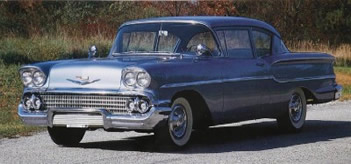 announced that state police vehicles would change from the standard gray hue. In order to address the problems of speeding motorists and a rising fatality rate, the state police would utilize unmarked cars of various colors. Apparently, the marked cars used during the period were easily identified by speeding motorists and were considered detrimental to the department’s traffic enforcement effort.
announced that state police vehicles would change from the standard gray hue. In order to address the problems of speeding motorists and a rising fatality rate, the state police would utilize unmarked cars of various colors. Apparently, the marked cars used during the period were easily identified by speeding motorists and were considered detrimental to the department’s traffic enforcement effort.
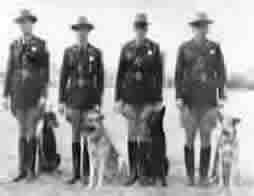
On September 13, 1958, three highly trained canines were considered to be members of the department. The first canine corps consisted of a Doberman Pinscher, a German Shepherd and a Belgian Sheep Dog. The dogs were trained in obedience, track and search and command attack with the assistance of the canine section of the Dover Air Force Base Security Police. Canine units have continued to be a mainstay of the department’s operations ever since.
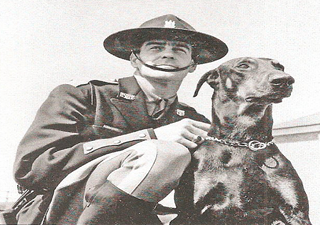
The department would be presented with a new set of challenges during the coming decade as the First State dealt with the problems of an ever-increasing population, crime and civil unrest. Delaware would not be spared from the effects of the Vietnam War, racial strife and the increased influx of illegal drugs which would plague the entire nation.
